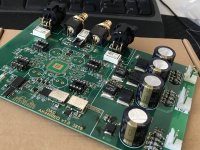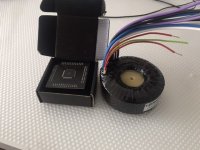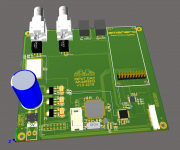AK4499 is now working on an experimental level. He isn't an engineer but has another project about SARADC(LTC2380-24).
http://innocent-key.com/wordpress/?page_id=12726
http://innocent-key.com/wordpress/?page_id=12726
Ak4499 dac:
Новый Hxmelody (Wilmer Workshop) AK4499 DAC 2019 купить в Москве на Avito — Объявления на сайте Авито
and japanese ak4499 double mono dac card:
AK4499DM DAC基板
What do you think?
Новый Hxmelody (Wilmer Workshop) AK4499 DAC 2019 купить в Москве на Avito — Объявления на сайте Авито
and japanese ak4499 double mono dac card:
AK4499DM DAC基板
What do you think?
What do you think?
I would suggest to wait for some user reviews comparing them to well-known good dacs to give some idea of how the new dacs sound. How they look says little or nothing about sound quality. Even if they were found to measure very well that would not tell the whole story about how they sound.
I would suggest to wait for some user reviews comparing them to well-known good dacs to give some idea of how the new dacs sound. How they look says little or nothing about sound quality. Even if they were found to measure very well that would not tell the whole story about how they sound.
Hi Mark, thank you for your answer.
Don’t worry, I wasn’t about to try to buy one of these.😄
I just found them yesterday night and wanted to share, cause I think they are some of the first Dac using that chip.( except the mobile one)
I thought that someone could tell if they are good or bad implementations after seeing the pictures and translating the info.
Did you made progress with the ak4499 dev board?
It’s very exiting but you didn’t post about it for a while.
Regards,
Terry
Did you made progress with the ak4499 dev board?
It’s very exiting but you didn’t post about it for a while.
Yes, some progress. Working on finding out how it works with different types of voltage regulators. They do affect the sound, especially so for the +15v input power for the Jung regulators. I am going to stiffen up the feedback gain of that particular shunt regulator to see what it does to/for the sound. I also disconnected the default +-15v for the I/V stages and made it so I could run those on a separate regulator. Don't know why AKM didn't make that easier to do. With the different power loads on separate regulators (much like I did with Sabre) its possible reduce distortion and better find out where problem areas are.
Also, experiments with different cables between the eval board outputs (which are passively filtered) and the headphone amp balanced input strongly suggest some low level RF is still making its way out of the eval board. That is also a problem that has been seen with various implementations of Sabre dacs. Chord mentions it as a problem in one of their youtube live presentations too. Anyway, its something I need to deal with since it can affect the sound quality of a differential summing stage.
We tried a number of different clock sources and settled on a USB board that sounds like it produces the lowest jitter. However, I want to try that USB board with some external Accusilicon clocks.
Bass distortion was reduced early on, but the basic AKM Reference Voltage scheme has been retained so far. It can sound quite good now, but the goal is to see if we can find more ways to get further improvements in sound quality. Measurements are important too of course, but they don't correlate exactly with how people hear, so we need to do a lot of trial and error listening experiments. It is expected to take time, but its interesting and hopefully we will learn some useful things along the way.
Last edited:
Ak4499 dac:
Новый Hxmelody (Wilmer Workshop) AK4499 DAC 2019 купить в Москве на Avito — Объявления на сайте Авито
and japanese ak4499 double mono dac card:
AK4499DM DAC基板
What do you think?
Top one (Wilmer workshop) is using BB OPA2604 opamps for I-V.
IME, (this is my direct experience not something I've read on the internet) is
that the 2604 is a fairly colored opamp and definitely clouds some nformation
in the process of sounding 'sort of nice'. Biasing into class A definitely helps
a lot but ultimately there are better suited opamps for I-V, especially the
AK4499 which has serious OP current swing. It's not the best measuring
opamp either.
If they chose the 2604 based on listening tests then IME something else
must be slightly amiss.
T
Ak4499 dac:
Новый Hxmelody (Wilmer Workshop) AK4499 DAC 2019 купить в Москве на Avito — Объявления на сайте Авито
and japanese ak4499 double mono dac card:
AK4499DM DAC基板
What do you think?
OK, just briefly checked out the second one (yanasoft.) and translated the
pdf.
IME this designer(s), has historically done some extremely high level and
interesting audio projects. Very switched on designer.
I can already see some thing's that have been addressed, it's potentially
a good board but it's also expensive and you would be foolish to go into a
project like this without at least a 100MHz cro, decent electronics knowledge
and probably a bit ore info from the designer WRT some of the choices that
were made.
My 2 cents
T
Ak4499 dac:
Новый Hxmelody (Wilmer Workshop) AK4499 DAC 2019 купить в Москве на Avito — Объявления на сайте Авито
and japanese ak4499 double mono dac card:
AK4499DM DAC基板
What do you think?
The second board($310, major parts included) doesn't include I/V stage. You need I/V board($10 PCB only ) designed for that purpose.
I/Vオペアンプ3基板
schematic http://www.yanasoft.jp/yana/IV_OPAMP3_1_0C.pdf
IMHO, it's challenging for a DIYer to have a successful result with the board because you need to order some necessary parts and a controller board with LCD and Ir remote.
Here is another project with AK4499. I/V conversion with 72mApp(recommended operation by the datasheet) is an incredibly strict requirement if you want more than 120dB THD. His performance is also under the physical low, excellent noise floor with pretty poor THD. THD is almost 100dB.
http://innocent-key.com/wordpress/?page_id=12726
ADA4898 couldn't supply 72mA, opa1612 became unstable. Above measurement was done by opa1602. I don't know you can find a suitable opamp which can feed high current without degrading THD.
As to SQ, he wrote opamp, oscillator and external DSP are essential to overcome AK4497. Without them, he concludes that AK4499 is inferior to AK4497. I guess he isn't an electrical engineer but a mastering one with a professional ear. I don't know how external DSP functions and why internal one is poor for his ear. Anyway, one subjective impression about AK4499.
Topping D90 announced.
D90 uses XMOS+CPLD+AK4118+AK4499 and Thesycon drivers. USB and IIS support up to PCM32bit/768kHz and DSD512 native; Optical, Coaxial and AES support up to PCM24bit/192kHz; Bluetooth support up to PCM24bit/96kHz(LDAC).
D90 coming soon,Company news,TOPPING
D90 uses XMOS+CPLD+AK4118+AK4499 and Thesycon drivers. USB and IIS support up to PCM32bit/768kHz and DSD512 native; Optical, Coaxial and AES support up to PCM24bit/192kHz; Bluetooth support up to PCM24bit/96kHz(LDAC).
D90 coming soon,Company news,TOPPING
TI probably doesn't feel the need to compete in this inaudible spec war.
Only spec I'm interested in when it comes to a piece of audio equipment is: does in take the veils off.
Possible scientific results:
A) yes
B) no
C) uuuhhh le le le je ne sais quoi (for you french speakers you know exactly what this means, as for me I'm still trying to figure it out)
D) I'm too high to tell (likely spec, if you're American)
E) All of the above (this spec the most sense to me)
Last edited:
My DAC based on AK4499EQ
At the end of this year I hope it will run.
What is the point of the exercise, to say you did it?
What is the point of the exercise, to say you did it?
I wanted to share my work. Maybe someone will give me Feedback of my work or will have any questions.
I probably chose the wrong topic.
Maybe someone will give me Feedback of my work or will have any questions.
Feedback we can do here, no problem. May I asked if you had a chance to look at the AK4499 evaluation board schematic before starting on your project?
Also, what kind of sound quality are you hoping to get?
Last edited:
My DAC based on AK4499EQ...
Forgot to mention the Crystek clocks shown in the first picture are the wrong frequencies for most AK4499 use, including for all DSD sample rates.
- Home
- Source & Line
- Digital Line Level
- AK4499EQ - Best DAC ever


